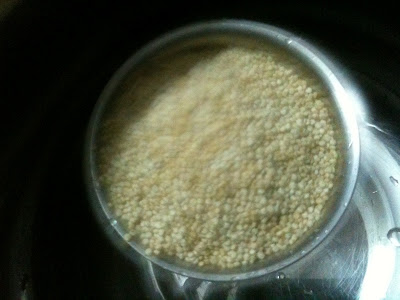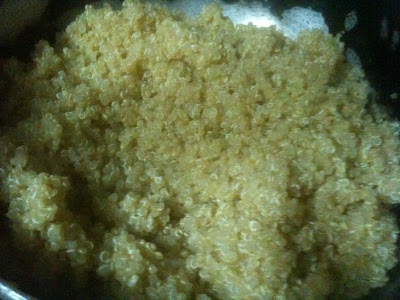Thiruvathira occurs during late December or early January during the Tamil month of Markazhi (which is the "spring" month, considered very sacred and during which we sing the praise of Gods (hence the kutcheris in Mylapore)).
In Kerala and Tamilnadu, women eat a special food preparation called "Kali" on this day and pray for a good husband. Married women fast for the longevity of their husbands. Thiruvadharai Kali is paired up with either Kootu or Thalaga Kuzhambu, according to one's family tradition. Being a "neivedhyam" food and made specifically for fasting, this kali and kootu, kuzhambu have barely any spices. Nonetheless, it is very delicious and absolutely healthy! You can make it even on a normal day when you want to try something different!
 |
| Thiruvadharai Kali |
Yield : For 2 adults for 2 meals (lunch and dinner)
Recipe for Thiruvathira Kali -
Rice - 1 cup
Jaggery - 1/2 cup
Coconut - 1/2 cup
Cardamom powder - ~1/4 tsp
Cashewnuts and Raisins - about 12 numbers each
Ghee - 1+ 1 tsp
Method -
- Wash rice and drain the water.
- Heat a pan and fry the wet rice until it runs slightly reddish.
- Let cool and then coarsely powder (like rava) the rice.
- Measure the powder and add 2 measures of water for every measure of this powdered rice. Pressure-cook for 10 minutes.
 |
| Rice, washed and about to get roasted |
 |
| Roasted and ready to be powdered |
 |
| Coarsely powdered rice |
 |
| Cooked! |
- Heat jaggery in a pan with some water sprinkled on it. When jaggery has melted, add grated coconut and cardamom powder.
- Mix in the rice powder, that's pressure-cooked.
- Ghee-roast cashews and raisins and add them too.
- Flavour the kali with another teaspoon of ghee!
 |
| Jaggery boiled. Remove the scum, if any. |
 |
| Coconut, cardamom added to jaggery |
 |
| Garnishing kali with cashews and raisins. I just dug a well in the middle of the kadai, heated some ghee and roasted them! |
 |
| Flavorful Kali is ready for neivedhyam! |
Recipe for Kootu -
 |
| Kootu / Thalaga kuzhambu for Thiruvadharai Kali |
- You need 5 or 7 different vegetables. Choose from brinjal/eggplant, carrot, raw banana (vazhakkai), green peas, sweet potato, colocasia (cheppan kizhangu/arbi), potato, beans, etc.
Dry-roast the following in a pan and grind into a paste with a little water
- Dhania (coriander seeds) - 1 tbsp
- Dry red chillies - 4 or 5
- Channa dal (kadala paruppu) - 1 tbsp
- Grated coconut - 2 tbsp
 |
| Dry-roasted |
 |
| Added some water and blended into a paste |
Method -
- Cook the vegetables with salt and turmeric.
- Add the paste (above) to the cooked vegetables. Add a little water if the mixture is too thick. Boil for a minute or two.
- Add curry leaves finally. That's it.
 |
| Potatoes, Sweet potatoes and Colocasia getting cooked |
 |
| Cooked and chopped! |
 |
| Carrots and peas cooked in microwave! |
 |
| Boiled together with the paste |
Variation for Thalaga kuzhambu -
Like for any kuzhambu, you need
tamarind water for this one too. So, boil together cooked veggies in tamarind extract. The procedure is pretty much the same as for kootu, but you add
white sesame to the paste. Add the prepared paste and finally add curry leaves, like for kootu. Voila!
 |
| A rather thick thalaga kuzhambu with lots of veggies! |
Enjoy your Kali with either Kootu or Thalaga kuzhambu. I personally prefer Kuzhambu as Kali is a bit dry and Thalaga kuzhambu is a richer gravy to go with it.The tartness from tamarind is also a nice combination with the rather sweet Kali.
I know it's quite late to post this recipe, but better late than never! Hope it's useful for folks for the next year's Thiruvathira! :-)

























